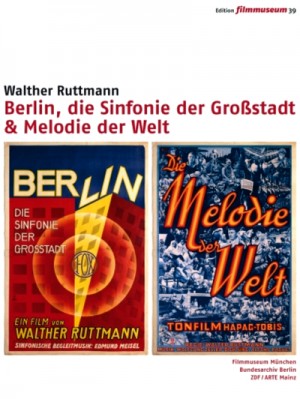Berlin, die Sinfonie der Großstadt & Melodie der Welt / Berlin: Symphony of a Great City & Melody of the World (1920 – 1931) 2 x DVD9
on August 7th, 2015 at 10:21
Walther Ruttmann is a pioneer of modern multimedia art. His first short films are unique experiments with forms, colors, and rhythm, his innovative commercials connected abstract animation art with concrete messages.
Ruttmann was born in Frankfurt in 1887 and died in Berlin in 1941. Academically trained as a mathematician, musician, and painter, he entered the world of filmmaking by creating a series of animated shorts featuring an interplay of abstract form, color and music. Some of these animations were commercial commissions, others were purely experimental.
The symphonic documentary Berlin, die Sinfonie der Großstadt is one of the most famous silent classics, the travelogue Melodie der Welt became the first German sound feature film. With the radio play Weekend Ruttmann created the first "sound film without images" while his short In der Nacht transforms music to images and is a prototype of modern music videos.
Berlin: Die Sinfonie der Großstadt & Melodie der Welt, the new two-disc set includes the entire surviving oeuvre of German filmmaker Walter Ruttmann from 1920-1931 in newly restored and reconstructed versions, often with original scores. It also includes lobby cards, posters, programs and text documents as well as little known paintings and drawings by Ruttmann.

2 x DVD9 | PAL 4:3 | 01:04:23 + 00:48:21 | 5.06 Gb + 6.49 Gb + 3% rec
Language: Deutsch
Subtitles: none
Genre: Documentary, Animation, Short
The surviving commercial animations included in this set soft sell tires (Der Sieger, 1922, 3:01), liquor (Das Wunder, 1922, 2:45), a florist (Das widergefundene Paradies, 1925, 5:26), health tonic (Der Aufstieg, 1926, 2:44), shortwave radios (Spiel der Wellen, 1926, 2:44), and newspapers (Dort wo der Rhein..., 1927, 5:27), while the surviving experimental animations include the sequentially title Opus I-IV, created between 1920 and 1925, totaling 23:39.
Leaving animation behind, Ruttmann embarked on his most ambitious project in 1926, a 65-minute experimental documentary about Berlin featuring a montage of city scenes with symphonic accompaniment. While inspired by the Paul Strand and Charles Sheeler's filmic ode to New York City, Manhatta (1924), and Alberto Cavalcanti's to Paris, Rien que les heures (1926), Ruttmann's Berlin: Die Sinfonie der Großstadt (Berlin: Symphony of a Great City), owes at least as much to Dziga Vertov's non-narrative documentary films, made with hidden cameras, seeking deeper truths apparent only through dialectic montage (Kino-Pravda).
Though shot over the course of a year, Berlin: Die Sinfonie der Großstadt's narrative structure is the life of the city during a single day from dawn till midnight. The film is divided into five acts each with an opening and closing title card, but without narration or intertitle. The acts cover the waking of the city (I Akt), the beginning of the day for school children and workers (II Akt), the bustle of mid-morning street life (III Akt), lunch and the end of the work and school day (IV Akt), and finally the city's varied night life (V Akt).
Although shot almost entirely with static cameras, Berlin creates a sense of frenzied movement through the use of montage, the frequent use of objects and people in motion, and through a driving symphonic score by Edmund Meisel.
Berlin was made during the Golden Era of the Weimar Republic as the nation was emerging from a long period of hyperinflation and tumultuous politics. Many Germans then believed that Germany could steer a centrist course clear of the perceived extremes of fascism or communism, and in this light, Ruttmann's de-emphasis on politics in Berlin is understandable, as is the good cheer of Germany's first talkie, Ruttmann's 48-minute travelogue Melodie der Welt completed in 1929, just as the Golden Era ended with the sudden death of liberal statesman Gustav Stresemann.
Financed by a German ocean liner company, Melodie der Welt, uses a sailor traveling the world as the narrative device, yet rather than present the world as a sequential series of locals as the sailor would have experienced it, Ruttmann creates a collage, grouping like things from around the world--beautiful women, music, stage production, work, children, and the like--leaving the sailor to offer only occasional reaction shots that don't mesh with the surrounding material. Melodie der Welt is ultimately a flawed, but engaging look at the world through liberal German eyes just on the eve of the rise of fascism and world war.
Also included in the set are a gallery of 23 paintings and drawings done by Ruttmann between 1911 and 1920, the eleven-minute radio play, Weekend (1930), and the seven-minute short In der Nacht (1931).
Besides the films, radio play, and drawings of Walter Ruttmann identified above, this set also includes a 1987 German-language radio documentary, Walther Ruttmann, der Visionär bewegter Rhythmen (86 min.); an unrestored version of Lichtspiel Opus 1; full-length four-panel comparisons of existing prints of Dort wo der Rhein and Melodie der Welt from which the final prints were assembled; photo galleries of lobby cards and original artwork for Berlin: Die Sinfonie der Großstadt (23 images) and from the Congress of the Independent Film at the Swiss castle of La Sarraz in 1929 (21 images).
Berlin.die.Sinfonie.1927.Lc.D1.part1.rar
Berlin.die.Sinfonie.1927.Lc.D1.part2.rar
Berlin.die.Sinfonie.1927.Lc.D1.part3.rar
Berlin.die.Sinfonie.1927.Lc.D2.part1.rar
Berlin.die.Sinfonie.1927.Lc.D2.part2.rar
Berlin.die.Sinfonie.1927.Lc.D2.part3.rar
Berlin.die.Sinfonie.1927.Lc.D2.part4.rar
















Thanks buddy